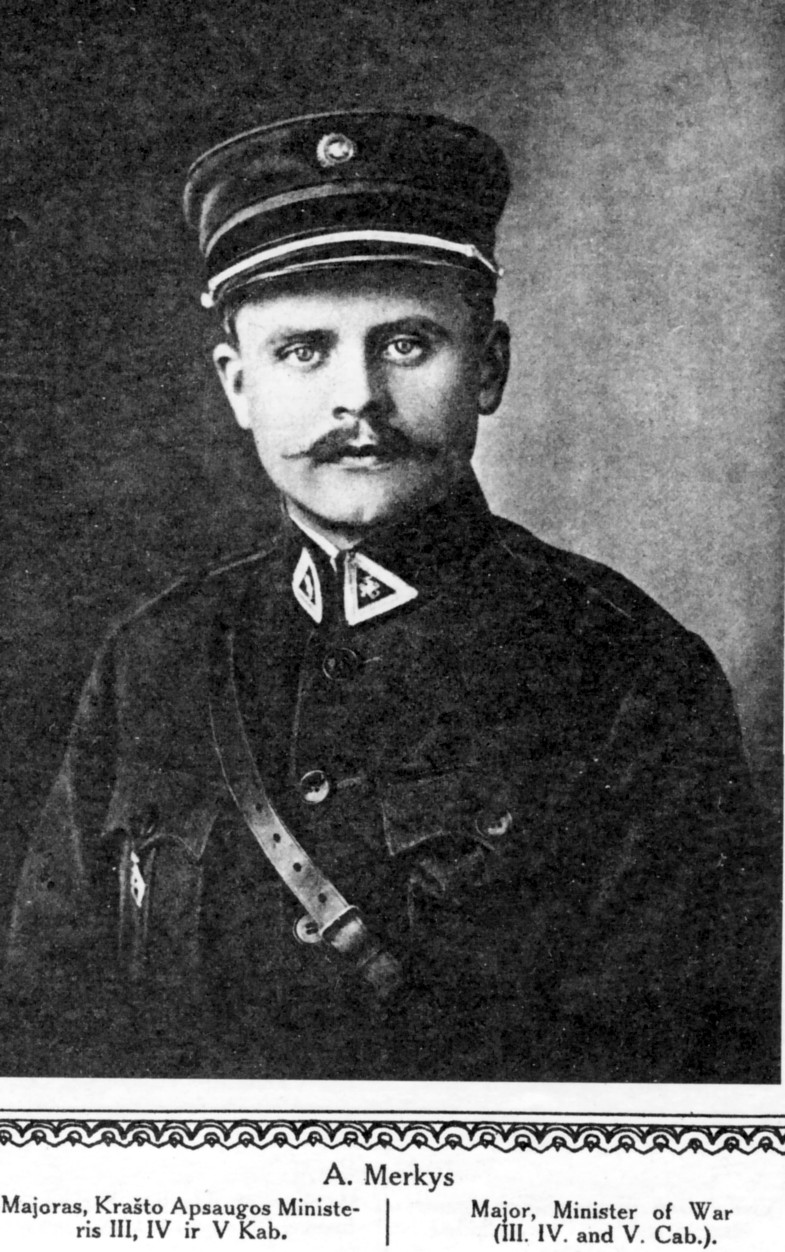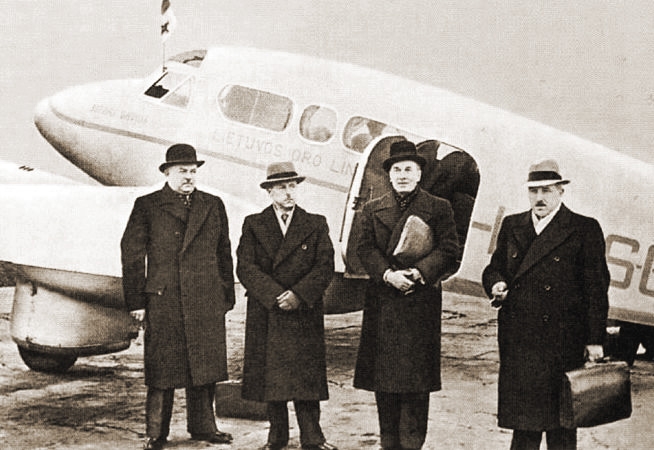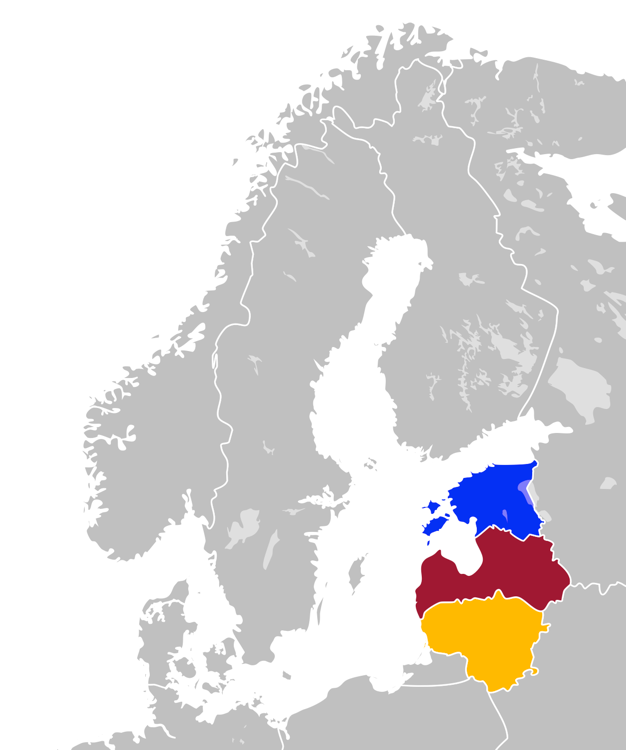|
People's Government Of Lithuania
The People's Government of Lithuania () was a puppet cabinet installed by the Soviet Union in Lithuania immediately after Lithuania's acceptance of the Soviet ultimatum of June 14, 1940. The formation of the cabinet was supervised by Vladimir Dekanozov, deputy of Vyacheslav Molotov and a close associate of Lavrentiy Beria, who selected Justas Paleckis as the prime minister and acting president. The government was formed on June 17 and, together with the People's Seimas (parliament), transitioned independent Lithuania to a socialist republic and the 14th republic of the Soviet Union thus legitimizing the Soviet occupation of Lithuania. The People's Government was replaced by the Council of People's Commissars of the Lithuanian SSR on August 25. Similar transitional People's Governments were formed in Latvia (Prime Minister Augusts Kirhenšteins supervised by Andrey Vyshinsky) and Estonia (Prime Minister Johannes Vares supervised by Andrei Zhdanov). Formation The Molotov–Ri ... [...More Info...] [...Related Items...] OR: [Wikipedia] [Google] [Baidu] |
Puppet State
A puppet state, puppet régime, puppet government or dummy government is a State (polity), state that is ''de jure'' independent but ''de facto'' completely dependent upon an outside Power (international relations), power and subject to its orders.Compare: Puppet states have nominal Sovereign state, sovereignty, except that a foreign power effectively exercises control through economic or military support. By leaving a local government in existence the outside power evades all responsibility, while at the same time successfully paralysing the local government they tolerate. Puppet states differ from Alliance, allies, who choose their actions of their own initiative or in accordance with Treaty, treaties they have voluntarily entered. Puppet states are forced into Rubber stamp (politics), legally endorsing actions already taken by a foreign power. Characteristics Puppet states are "endowed with the outward symbols of authority", such as a name, National flag, flag, anthem, cons ... [...More Info...] [...Related Items...] OR: [Wikipedia] [Google] [Baidu] |
Johannes Vares
Johannes Vares (pen name Barbarus or Vares-Barbarus – 29 November 1946) was an Estonian poet, medical doctor, and politician. Early life and education Vares was born in a farmer family in the village of Kiisa, near Viljandi, Estonia. He received secondary education at Pärnu Gymnasium, and in 1910–1914 studied medicine at the University of Kyiv. Medical career Vares served as a military physician in World War I, and after that as a military physician for the Estonian Army during the Estonian War of Independence (1918–1920). He was awarded the Estonian Cross of Liberty for the participation. In the 1920s, Vares started working as a medical doctor in Pärnu. He subsequently became a well-known poet as well as a radical socialist, using the pen name Johannes Barbarus. Prime minister of Estonia During World War II, after the Stalinist Soviet Union invaded and occupied Estonia in June 1940, Andrei Zhdanov, leader of the Soviet aggression, forced the Estonian pre ... [...More Info...] [...Related Items...] OR: [Wikipedia] [Google] [Baidu] |
Nazi Germany
Nazi Germany, officially known as the German Reich and later the Greater German Reich, was the German Reich, German state between 1933 and 1945, when Adolf Hitler and the Nazi Party controlled the country, transforming it into a Totalitarianism, totalitarian dictatorship. The Third Reich, meaning "Third Realm" or "Third Empire", referred to the Nazi claim that Nazi Germany was the successor to the earlier Holy Roman Empire (800–1806) and German Empire (1871–1918). The Third Reich, which the Nazis referred to as the Thousand-Year Reich, ended in May 1945, after 12 years, when the Allies of World War II, Allies defeated Germany and entered the capital, Berlin, End of World War II in Europe, ending World War II in Europe. After Hitler was appointed Chancellor of Germany in 1933, the Nazi Party began to eliminate political opposition and consolidate power. A 1934 German referendum confirmed Hitler as sole ''Führer'' (leader). Power was centralised in Hitler's person, an ... [...More Info...] [...Related Items...] OR: [Wikipedia] [Google] [Baidu] |
Antanas Smetona
Antanas Smetona (; 10 August 1874 – 9 January 1944) was a Lithuanian intellectual, journalist and politician. He served as the first president of Lithuania from 1919 to 1920 and later as the authoritarian head of state from 1926 until the Occupation of the Baltic states, Soviet occupation of Lithuania in 1940. Referred to as the "Leader of the Nation" during his presidency, Smetona is recognised as one of the most important Lithuanian political figures between World War I and World War II, and a prominent ideologist of Lithuanian National Revival, Lithuanian nationalism and the movement for national revival. Born into a farming family in the village of Užulėnis, Kovno Governorate, Smetona exhibited a strong interest in education and Lithuanian cultural identity from an early age. He attended Palanga Progymnasium and later graduated from Jelgava Gymnasium. He pursued higher education at the Saint Petersburg Imperial University, where he studied law and became involved in natio ... [...More Info...] [...Related Items...] OR: [Wikipedia] [Google] [Baidu] |
Stasys Raštikis
Stasys Raštikis (September 13, 1896 – May 3, 1985) was a Lithuanian military officer, ultimately obtaining the rank of divisional general. He was Chief of Defence (Lithuania), the commander of the Lithuanian Army from September 21, 1934, to April 23, 1940. During World War I, he served in the Imperial Russian Army mostly in the Caucasus Campaign. After return to Lithuania in 1918, he joined the newly formed Lithuanian Army and fought in the Lithuanian–Soviet War. He was severely injured and spent 20 months in Soviet captivity. He returned to the 5th Infantry Regiment (Lithuania), 5th Infantry Regiment and later joined the Intelligence Department of the Defence Staff (Lithuania), General Staff. The 1926 Lithuanian coup d'état, coup d'état of December 1926 brought his future wife's uncle, Antanas Smetona, to power, which propelled his career. Raštikis completed military education in Germany and, after the 1934 Lithuanian coup d'état attempt, failed military coup in 1934, bec ... [...More Info...] [...Related Items...] OR: [Wikipedia] [Google] [Baidu] |
Antanas Merkys
Antanas Merkys (; 1 February 1887 – 5 March 1955) was the last Prime Minister of independent Lithuania, serving from November 1939 to June 1940. When the Soviet Union presented an ultimatum to Lithuania demanding that it accept a Soviet garrison, President Antanas Smetona fled the country leaving Merkys as acting president. Merkys ostensibly cooperated with the Soviets, and illegally took over the presidency in his own right. After three days, Merkys handed power to Justas Paleckis, who formed the People's Government of Lithuania. When Merkys attempted to flee the country, he was captured and deported to the interior of Russia, where he died in 1955. Biography Merkys was born at Bajorai, near Skapiškis. Educated in law, he served in the Russian Army during World War I (1914–18). In 1919, he served as the newly independent Lithuania's Minister of Defence before serving with the Lithuanian Army until his decommissioning in 1922. He then practised as a lawyer. After ... [...More Info...] [...Related Items...] OR: [Wikipedia] [Google] [Baidu] |
Red Army
The Workers' and Peasants' Red Army, often shortened to the Red Army, was the army and air force of the Russian Soviet Republic and, from 1922, the Soviet Union. The army was established in January 1918 by a decree of the Council of People's Commissars to oppose the military forces of the new nation's adversaries during the Russian Civil War, especially the various groups collectively known as the White Army. In February 1946, the Red Army (which embodied the main component of the Soviet Armed Forces alongside the Soviet Navy) was renamed the "Soviet Army". Following the dissolution of the Soviet Union it was split between the post-Soviet states, with its bulk becoming the Russian Ground Forces, commonly considered to be the successor of the Soviet Army. The Red Army provided the largest land warfare, ground force in the Allies of World War II, Allied victory in the European theatre of World War II, and its Soviet invasion of Manchuria, invasion of Manchuria assisted the un ... [...More Info...] [...Related Items...] OR: [Wikipedia] [Google] [Baidu] |
Vilnius Region
Vilnius Region is the territory in present-day Lithuania and Belarus that was originally inhabited by ethnic Baltic tribes and was a part of Lithuania proper, but came under East Slavic and Polish cultural influences over time. The territory included Vilnius, the historical capital of the Grand Duchy of Lithuania. Lithuania, after declaring independence from the Russian Empire, claimed the Vilnius Region based on this historical legacy. Poland argued for the right of self-determination of the local Polish-speaking population. As a result, throughout the interwar period the control over the area was disputed between Poland and Lithuania. The Soviet Union recognized it as part of Lithuania in the Soviet–Lithuanian Peace Treaty, but in 1920 it was seized by Poland and became part of the short-lived puppet state of Central Lithuania, and was subsequently incorporated into the Second Polish Republic. Direct military conflicts ( Polish–Lithuanian War and Żeligowski's Mutin ... [...More Info...] [...Related Items...] OR: [Wikipedia] [Google] [Baidu] |
Soviet–Lithuanian Mutual Assistance Treaty
The Soviet–Lithuanian Mutual Assistance Treaty (, ) was a bilateral treaty signed between the Soviet Union and Lithuania on October 10, 1939. According to provisions outlined in the treaty, Lithuania would acquire about one fifth of the Vilnius Region, including Lithuania's historical capital, Vilnius, and in exchange would allow five List of Soviet Union military bases abroad, Soviet military bases with 20,000 troops to be established across Lithuania. In essence the treaty with Lithuania was very similar to the treaties that the Soviet Union signed Soviet–Estonian Mutual Assistance Treaty, with Estonia on September 28, and Soviet–Latvian Mutual Assistance Treaty, with Latvia on October 5. According to Soviet propaganda, official Soviet sources, the Soviet military was strengthening the defenses of a weak nation against possible attacks by Nazi Germany. The treaty provided that Lithuania's sovereignty would not be affected. However, in reality the treaty opened the door for ... [...More Info...] [...Related Items...] OR: [Wikipedia] [Google] [Baidu] |
Territories Of Poland Annexed By The Soviet Union
Seventeen days after the German invasion of Poland in 1939, which marked the beginning of the Second World War, the Soviet Union entered the eastern regions of Poland (known as the ) and annexed territories totalling with a population of 13,299,000. Inhabitants besides ethnic Poles included Belarusian and Ukrainian major population groups, and also Czechs, Lithuanians, Jews, and other minority groups. These annexed territories were subsequently incorporated into the Lithuanian, Byelorussian, and Ukrainian Soviet Socialist Republics and remained within the Soviet Union in 1945 as a consequence of European-wide territorial rearrangements configured during the Tehran Conference of 1943 (see Western Betrayal). Poland was compensated for this territorial loss with the pre-War German eastern territories, at the expense of losing its eastern regions. The Polish People's Republic regime described the territories as the " Recovered Territories". The number of Poles in the Kresy i ... [...More Info...] [...Related Items...] OR: [Wikipedia] [Google] [Baidu] |
Politburo Of The Communist Party Of The Soviet Union
The Political Bureau of the Central Committee of the Communist Party of the Soviet Union, abbreviated as Politburo, was the de facto highest executive authority in the Communist Party of the Soviet Union (CPSU). While elected by and formally accountable to the Central Committee, in practice the Politburo operated as the ruling body of Soviet Russia and the Soviet Union from its creation in 1919 until the party's dissolution in 1991. Full members and candidate (non-voting) members held among the most powerful positions in the Soviet hierarchy, often overlapping with top state roles. Its duties, typically carried out at weekly meetings, included formulating state policy, issuing directives, and ratifying appointments. The Politburo was originally established as a small group of senior Bolsheviks shortly before the October Revolution of 1917, and was re-established in 1919 to decide on urgent matters during the Russian Civil War. It operated on the principles of democratic cent ... [...More Info...] [...Related Items...] OR: [Wikipedia] [Google] [Baidu] |
Baltic States
The Baltic states or the Baltic countries is a geopolitical term encompassing Estonia, Latvia, and Lithuania. All three countries are members of NATO, the European Union, the Eurozone, and the OECD. The three sovereign states on the eastern coast of the Baltic Sea are sometimes referred to as the "Baltic nations", less often and in historical circumstances also as the "Baltic republics", the "Baltic lands", or simply the Baltics. The term "Balticum" is sometimes used to describe the region comprising the three states; see e.g All three Baltic countries are classified as World Bank high-income economy, high-income economies by the World Bank and maintain a very high Human Development Index. The three governments engage in intergovernmental and parliamentary cooperation. There is also frequent cooperation in foreign and security policy, defence, energy, and transportation. Etymology The term ''Baltic'' stems from the name of the Baltic Sea – a hydronym dating back to at least ... [...More Info...] [...Related Items...] OR: [Wikipedia] [Google] [Baidu] |










